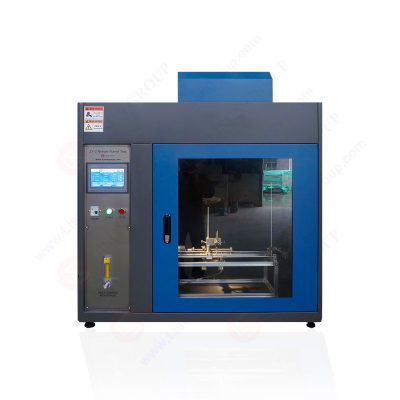
The needle flame test and the glow wire test are both used to assess the fire resistance of materials, but they differ in their testing principles and applications.
Needle Flame Test:
The needle flame test evaluates the risk of small flames that may occur under fault conditions in equipment. Specifically, this test utilizes a specified size (diameter of 0.9 millimeters) needle-like burner, which directs a specific gas (such as butane) at a 45-degree angle onto the test sample. The test observes whether the sample ignites, and measures the duration and length of combustion. This test assesses the impact of small internal flames due to equipment faults on safety.
Glow Wire Test:
In contrast, the glow wire test is used to assess the self-ignition and fire resistance of materials. During the test, a red-hot wire or mesh contacts the test sample, and the test observes whether the sample ignites or stops burning. This test determines the reaction of the material when heated at the contact point, thereby evaluating its fire resistance and self-ignition properties.
Therefore, the needle flame test and the glow wire test are two different methods for evaluating fire resistance. The needle flame test focuses on assessing the risk of small flames generated under equipment fault conditions, while the glow wire test emphasizes evaluating material self-ignition and fire resistance.
Glow Wire Test Procedure:
• Equipment and Materials:
Use a nickel-chromium wire with a diameter of Φ4 mm as the glow wire.
Heat the glow wire to the specified temperature range for testing (typically between 300°C to 1000°C).
Place the heated glow wire head onto the test sample with a fixed pressure (usually 1.0N).
• Testing Process:
Position the heated glow wire head on the surface of the test sample, apply the specified pressure, and maintain for 30 seconds.
Observe whether the test sample or padding ignites, and monitor the duration of combustion after ignition.
• Recorded Data:
Record the following data after testing:
Glow time: Duration of contact between the glow wire head and the sample.
Ignition time (Ti): Time at which the sample begins to ignite after contact with the glow wire head.
Flame extinction time (Te): Time at which the flame extinguishes after ignition.
Glow Wire Flammability Index (GWFI): Indicates the fire resistance performance of the sample during the glow wire test.
Analysis of Results:
Analyze the fire hazard and fire resistance performance of the sample based on the recorded data.
A higher Glow Wire Flammability Index (GWFI) value indicates better fire resistance performance during the glow wire test and lower fire hazard.
This testing method simulates high-temperature and high-pressure conditions that electrical and electronic equipment products may encounter during use, ensuring product safety and reliability under various conditions.
ZY-3 Needle Flame Test
The needle flame test and the glow wire test are two common fire testing methods with distinct differences:
• Flame Type:
Needle flame test uses an open flame generated by a burner directly applied to the sample for testing.
Glow wire test uses a heated wire as a heat source applied to the sample for testing.
• Testing Principles:
Needle flame test simulates a small flame ignition source to evaluate the fire resistance and durability of the sample.
Glow wire test evaluates the ignition hazard and fire resistance of materials under high-temperature conditions.
• Applicability:
Needle flame test is suitable for testing small components or parts, especially when other tests like glow wire or vertical/horizontal burning tests are not applicable.
Glow wire test is primarily used for larger electrical and electronic equipment products to evaluate their fire resistance under high temperatures.
• Testing Effects:
Needle flame test provides direct results with visible flame combustion, allowing observation of the sample’s burning behavior.
Glow wire test is relatively gentle, focusing on evaluating the sample’s combustion characteristics under high-temperature conditions.
• Supplementary Testing:
If ignition occurs during the glow wire test, a needle flame test may be conducted to further assess the fire hazard and fire resistance of the sample.
The needle flame test is commonly used to assess the fire resistance of materials and products, particularly in the lighting industry, electronic and electrical sectors, as well as insulation materials, engineering plastics, and solid combustible materials. The test adheres to specific standards and parameters to ensure accurate and comparable results across different products.
Standards and Parameters for Needle Flame Test:
Test Standards:
• GB 4706.1-2005 “General Requirements for Safety of Household and Similar Electrical Appliances.”
• IEC 60695-11-5:2016 “Fire hazard testing – Part 11-5: Test flames – Needle-flame test method – Apparatus, confirmatory test arrangement, and guidance.”
• GB/T 5169.5-2008 “Fire hazard testing for electric and electronic products – Part 5: Needle-flame test method – Apparatus, confirmatory test arrangement, and guidance.”
Instrument Settings and Test Parameters:
• Burner Angle: Typically set at 0°, 20°, or 45° to test material fire resistance from different angles.
• Flame Height: Maintained at 12±1mm for standardized testing consistency.
• Needle Burner: Made of stainless steel with a length ≥35mm and a diameter between 0.9mm and 0.5mm.
• Calibration Time: Set at 23.5±1 seconds to ensure accuracy and stability of test equipment and flame parameters.
• Temperature Testing: Maximum temperature reaches 1050°C ±0.1% to ensure flame temperature accuracy.
• Gas Type: Usually propane or butane with a purity greater than 95% as the combustion gas.
• Needle Flame Combustion and Sample Combustion Times: Adjustable burning time range from 0 to 999.9 seconds, used to record the duration of needle flame and sample combustion.
Implementing the needle flame test according to specific standards and parameter settings ensures accurate and comparable test results for assessing fire resistance and safety of different products.
https://www.lisungroup.com/news/technology-news/needle-flame-test-vs-glow-wire-test-understanding-the-differences.html
.jpg)
Comments
Post a Comment